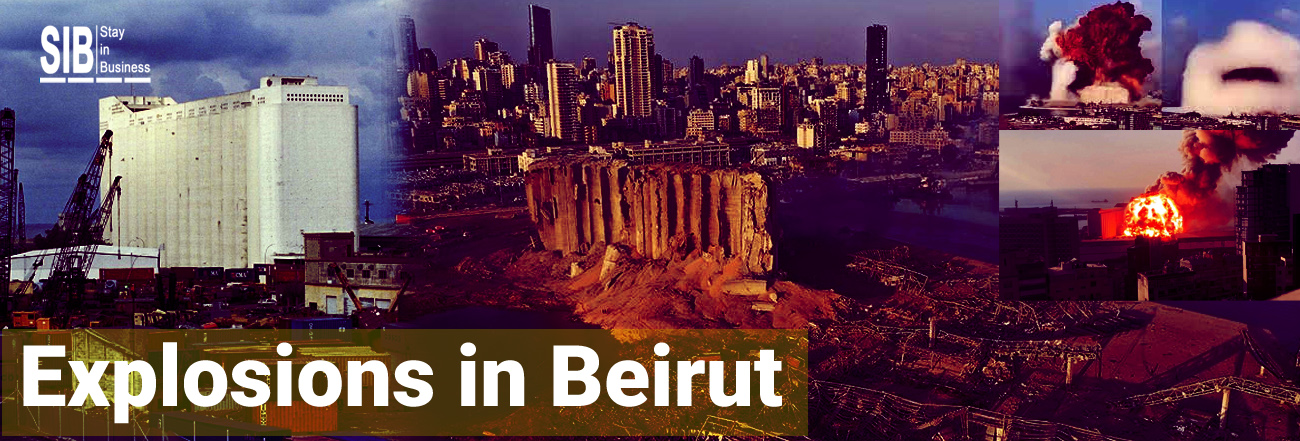Explosions in Beirut

More than hundred people lost their lives after two massive blasts struck the city of Beirut in Lebanon with widespread damage to constructions and infrastructure across the city.
The country’s prime minister confirmed that the explosion took place after more than 2,700 tons of ammonium nitrate caught fire. The prime minister said that the chemical had been stored for more than half a decade with inadequate protection measures which had led to the accident. He also went on to say that the individuals accountable for the incident would be severely dealt with.
Many thousands of people have been severely wounded while the number of fatalities continues to rise. Numerous homes were severely damaged, rendering them unfit for living, while large storage facilities for grain, a vital food resource given the country’s heavy reliance on overseas bread purchases, were also destroyed.
In an official communication, the US embassy urged residents to use masks and not venture outside as the blasts had led to the emissions of highly toxic gases.
Although until August 4th, there was some particulate present in the air, air quality had once again become “Good” by the end of the day.
Healthcare institutions found themselves incapable of meeting the demand although they were operating at full capacity attending to numerous patients. Many individuals had discarded their vehicles in the nearby highways to make a hasty escape and the explosions were audible as far as fifty miles to the north.
The accident had left local residents severely distressed and fearing the worst as the country’s economic growth prospects were already looking bleak. A two week emergency was imposed on Tuesday and the military formally took over the situation.
Needless to say, speculation was rife in international circles over the causes that led to the explosions. Nevertheless, some countries extended aid and support in a spirit of goodwill.
Initially, many suspected the explosion originated in a fireworks warehouse. However, deeper investigation revealed the source of the blasts to be in a warehouse where highly volatile ammonium nitrate chemicals were being stored without the proper protective measures.
The explosions were forceful enough for the vibrations to be felt across constructions and other structures in nearby areas. The number of fatalities is expected to rise steeply as emergency officials continue uncovering more corpses from the debris and ruined constructions.
Even healthcare facilities had been damaged because of the explosions in Beirut, making it almost impossible for doctors, physicians, nurses and other healthcare personnel to attend to those who needed immediate attention. Makeshift arrangements had to be hastily put together, often in the open, so that patients could be treated.
Videos recorded and shared on social media by civilian witnesses reveal two explosions, the first one relatively small that spread across a storage facility. The second explosion was significantly more massive and the impact was severe enough to cause vehicles in a close-by highway to be momentarily airborne while an overpass in the vicinity was also badly damaged. The port and other recreational zones nearby were also severely impacted.
Lebanon was caught completely off-guard by the accident and exposed on all fronts as the country was in the middle of an economic recession with salary cuts, layoffs, widespread penury and growing hostilities with some of its neighboring countries.
The nation’s minister of economy officially announced that all the wheat stock in Beirut’s port had been rendered unfit for consumption. Seven employees who worked in these wheat warehouses had also gone missing. Nevertheless, he also mentioned that the country could get by with its existing wheat reserves till fresh imports arrived.
The impact of the explosions in Beirut didn’t go unnoticed, not even in cities such as Larnaca in Cyprus, located at a distance of more than 100 miles. Many casualties were registered among United Nations personnel, including some of their family members and guests.
Many buildings in the port area were severely damaged while shipping vessels were torn to pieces and razed by fires. Individuals, including women and children, suffered severe burns and wounds. With very little succor coming to their rescue during financially troubled times, the locals were left distraught and with nowhere to go.
Categories: Disaster Recovery Planning, Fire, Safety
